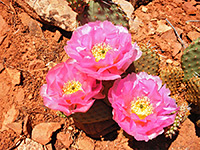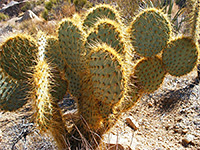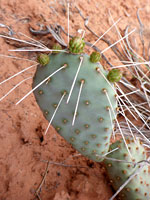Opuntia ('prickly pears') are branched, jointed cacti, usually densely spined, though a few species have no spines. They are characterized by flattened pads, unlike the related cylindropuntia genus (cholla), where the pads are cylindrical, and the low-growing, especially spiny grusonia genus (club cholla), where the pads are club-shaped; narrow at the base and wider towards the end. Some opuntia become large and tree-like while others stay at ground level, often forming extensive mats. There are many Southwest varieties, often similar in appearance, a few hybridized and many difficult to identify. The regular spines are surrounded by tiny bristles known as glochids, which are very irritating to the skin if touched. Opuntia are the most widespread US cactus genus, with nearly 40 species, growing in every state and in Canada.
Other US opuntia species:
Opuntia atrispina, border prickly pear, close to the Rio Grande in south Texas, around Del Rio
Opuntia cymochila, grassland prickly pear, Great Plains states (CO, KS, NE, NM, OK, TX)
Opuntia dillenii, erect prickly pear, Florida
Opuntia humifusa, eastern prickly pear, all of east and central USA
Opuntia macrorhiza, twist spine prickly pear (Great Plains, southern Rocky Mountain states and Arizona)
Opuntia martiniana, seashore cactus, northwest Arizona and southwest Utah
Opuntia monacantha, common prickly pear, southeast USA (AL, FL, GA, LA, MS)
Opuntia pusilla, cockspur prickly pear, southeast Texas, along the Gulf Coast to Florida and north along the Atlantic coast
Opuntia stricta, erect prickly pear, along the coast of southeast USA
Opuntia triacantha, Spanish lady, Florida (Keys)
Opuntia valida, San Antonio prickly pear, New Mexico
Other US opuntia species:
Opuntia atrispina, border prickly pear, close to the Rio Grande in south Texas, around Del Rio
Opuntia cymochila, grassland prickly pear, Great Plains states (CO, KS, NE, NM, OK, TX)
Opuntia dillenii, erect prickly pear, Florida
Opuntia humifusa, eastern prickly pear, all of east and central USA
Opuntia macrorhiza, twist spine prickly pear (Great Plains, southern Rocky Mountain states and Arizona)
Opuntia martiniana, seashore cactus, northwest Arizona and southwest Utah
Opuntia monacantha, common prickly pear, southeast USA (AL, FL, GA, LA, MS)
Opuntia pusilla, cockspur prickly pear, southeast Texas, along the Gulf Coast to Florida and north along the Atlantic coast
Opuntia stricta, erect prickly pear, along the coast of southeast USA
Opuntia triacantha, Spanish lady, Florida (Keys)
Opuntia valida, San Antonio prickly pear, New Mexico
All Contents © Copyright The American Southwest | Comments and Questions | Contribute | Affiliate Marketing Disclosure | Site Map

























